



India, Saudi sign strategic partnership pact, focus on security cooperation
In his second visit to Saudi Arabia after three-and-a-half years, Prime Minister Narendra Modi and Saudi King Salman bin Abdulaziz Al-Saud, condemned terrorism and agreed to step up bilateral security cooperation.
Key Agreements:
- Two countries signed a pact for establishment of a Strategic Partnership Council (SPC). India is the fourth country with which Saudi Arabia has formed such a strategic partnership, after UK, France and China.
- SPC will have two parallel tracks
- Political, security, culture and society, headed by Foreign Ministers.
- Economy and investment, headed by India’s Commerce Minister and Saudi’s Energy Minister.
- Two countries signed several agreements in defence industries, security, air services, renewable energy, medicine products regulation and prevention of narcotics trafficking.
- India thanked Saudi King for ensuring regular export of crude oil to India despite attacks on facilities of Saudi oil giant Aramco.
- Saudi Arabia supplies 18 per cent of India’s crude oil requirements and 30 per cent of its liquefied petroleum gas needs.
- A trilateral partnership has also been formed between Saudi Aramco, the Abu Dhabi National Oil Co and a consortium of Indian oil majors to set up the world’s largest Greenfield refinery in Raigarh. The proposed 1.2-million-barrel-per-day (bpd) refinery is likely to be commissioned by 2025, and is expected to help India raise its refining capacity by 77 per cent to 8.8 million bpd by 2030.
- The two sides will enhance maritime security cooperation and are considering joint naval exercises in 2020.
- Integration of India’s e-Migrate portal with the Saudi e-Thawtheeq system has been completed, and is expected to facilitate the smooth movement of the workforce.
State government has ordered installation of around one lakh prepaid electricity meters at government departments and houses allotted to lawmakers and officials as electricity arrears of such departments and houses stand at nearly Rs 13,000 crores.
Reasons behind the move:
- The decision was taken to fulfil the promise of 24-hour power supply in the state and to get a better national level Distribution Company (DISCOM) rating.
- With bad DISCOM rating, the state government now has to pay in advance to get electricity for the state.
Although the prepaid meters will not help with the arrears, it will make sure that from now on, no more bills are going to be pending.
Madras High Court made strong observations asking whether government needs a corpse to act on implementing each and every statute, hours after the decomposed body of a two-year-old boy was pulled out from an unused bore well.
Court Observation:
- Court rapped the media, saying it was not streaming anything constructive in creating public awareness on the implementation of rules and regulation on bore wells and tube wells.
- Everybody has a social responsibility to bring awareness.
- Media needs to publish the guidelines issued by the state government based on the Supreme Court’s order.
- The court asked details on the number of permissions granted and the list of contractors and entities that were accorded permission to dig bore wells and tube wells and list of unused and abandoned bore wells and tube wells as well as the penal action taken against the violators.
Supreme Court Guidelines on Tube well Regulations:

Following details need to be mentioned on signboard:
- Complete address of the drilling agency at the time of construction/ rehabilitation of well.
- Complete address of the user agency or owner of the well.
- Construction of cement or concrete platform measuring 0.50x0.50x0.60 meter (0.30 meter above ground level and 0.30 meter below ground level) around the well casing.
- Capping of well assembly by welding steel plate or by providing a strong cap to be fixed to the casing pipe with bolts and nuts.
- In case of pump repair, the tube well should not be left uncovered.
- Filling of mud pits and channels after completion of works.
- Filling up abandoned bore wells by clay, sand, boulders, pebbles or drill cuttings from bottom to ground level.
- On completion of the drilling operations at a particular location, the ground conditions should be restored as before the start of drilling.
- District Collector should be empowered to verify that the above guidelines are being followed and proper monitoring check about the status of boreholes or tube wells are being taken care through the concerned State or Central agencies.
Ever since the results of Periodic Labour Force Survey (PLFS) 2017-18 became public — they showed that unemployment in India was at a 45-year high — there has been vigorous public debate about the true state of unemployment in country.
Findings of new study of Economic Advisory Council:
- Study found that the total employment in the country grew by 4.5 crore in the 13 years between EUS 2004-05 and PLFS 2017-18.
- This represents a growth of just 0.8 per cent — less than half the rate at which the overall population grew, which was 1.7 per cent.
- Of the 4.5 crore increase in employment, 4.2 crore happened in the urban areas while rural employment either contracted (by 0.01 per cent between 2004 and 2011) or was stagnant (grew by 0.18 per cent between 2011 and 2017).
- Over the 13 years, male employment grew by 6 crore but female employment fell by 1.5 crore.
- Youth employment (those between the ages of 15 and 24) has fallen from 8.14 crore in 2004 to 5.34 crore in 2017.

- Employment in the 25-59 age group and the 60 years and above group has gone up.
- The sustained schooling reforms seem to have shown their impact in the employment of children below 14 years of age reducing from 61 lakh in 2004 to 27 lakh in 2011, and just 11 lakh in 2017.
- The emerging economy appears to be leaving behind the illiterates and those with incomplete primary education.
- Organized Employment: the rate of employment growth in the organised sector — that is, in firms that are registered with regulatory authorities and are bound by a variety of labour laws — has been the fastest, and its share in the total employed has raised from 8.9 per cent in 2004 to 14 per cent in 2017.
- The NSSO data show a sustained trend of even the organised sector in India preferring to employ workers without a contract.

© 2025 iasgyan. All right reserved